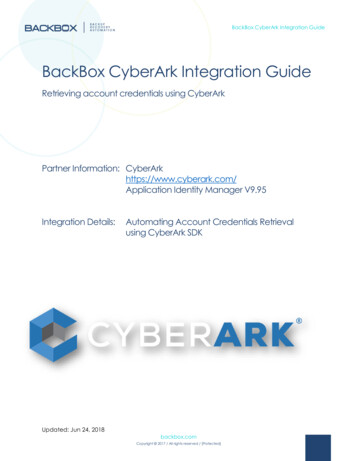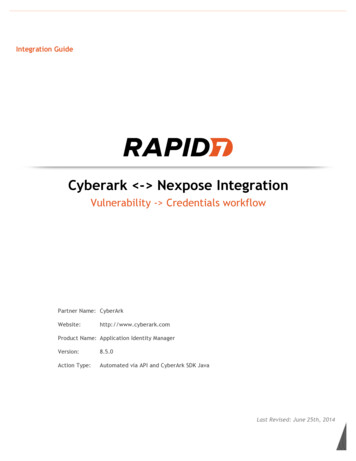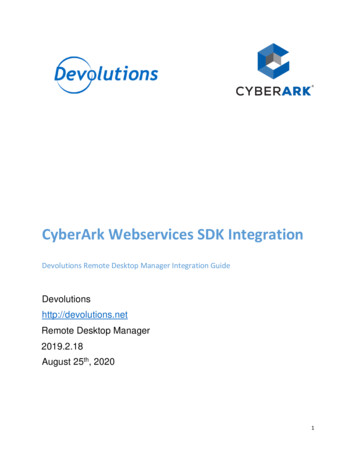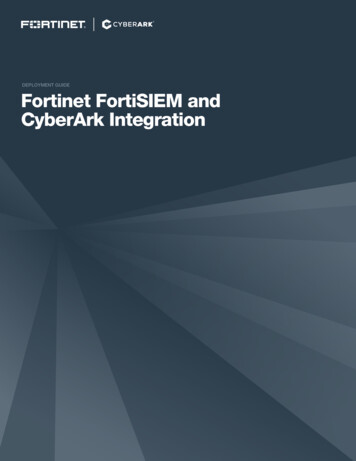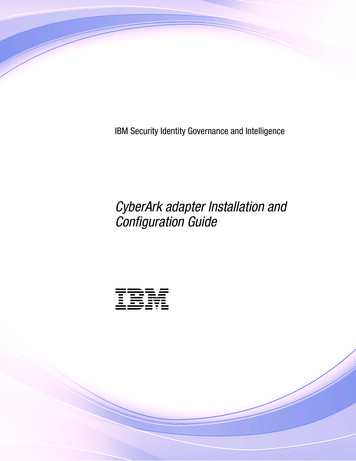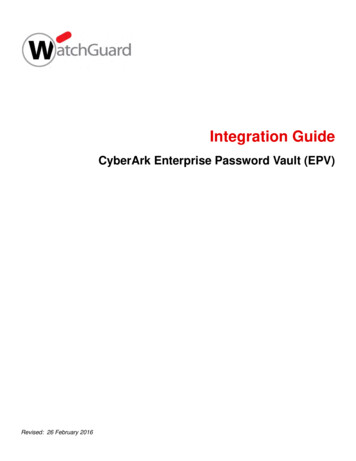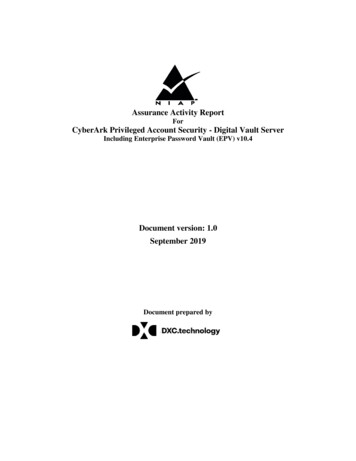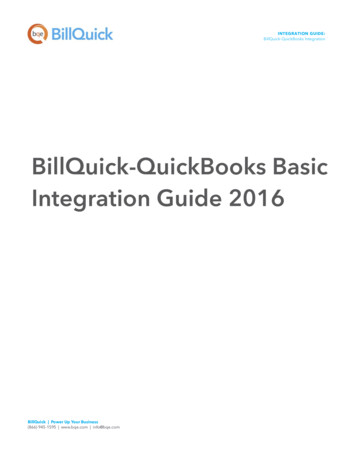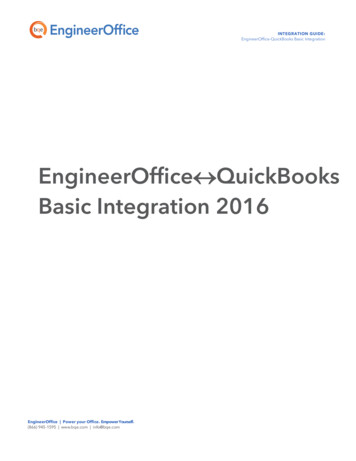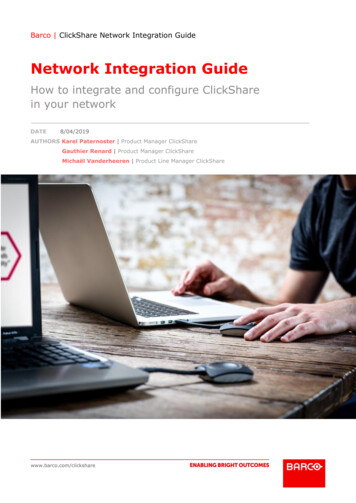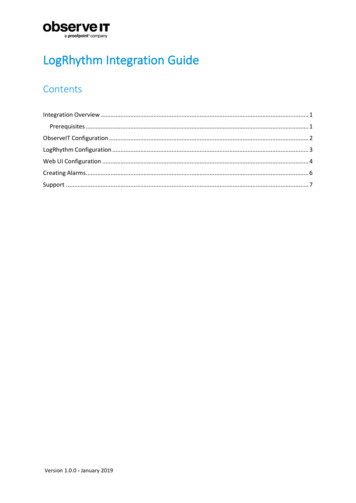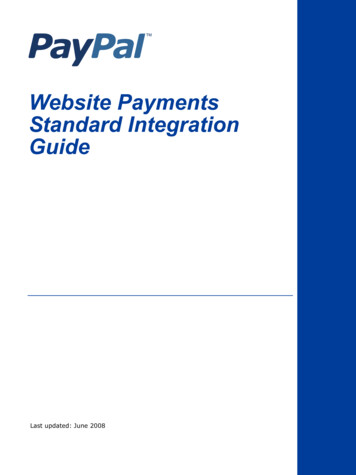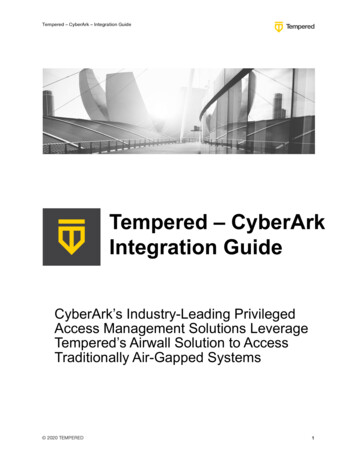
Transcription
Tempered – CyberArk – Integration GuideTempered – CyberArkIntegration GuideCyberArk’s Industry-Leading PrivilegedAccess Management Solutions LeverageTempered’s Airwall Solution to AccessTraditionally Air-Gapped Systems 2020 TEMPERED1
Tempered – CyberArk – Integration GuideTable of ContentsIntroduction . 3Overview . 4Solution Flexibility . 5Local Network to Local Network . 5HQ Network to Branch Network. 6Cloud Network to OnPrem Network. 6OnPrem Network to Cloud Network. 7Cloud Network to Cloud Network . 7CyberArk Server to Protected Server . 9Install Airwall Server on CyberArk PSM . 9Troubleshooting Airwall Server. 12Create Relay Rule and Overlay . 12Add an Airwall Relay Rule . 12Create an Overlay . 13Testing, Diagnostics and Troubleshooting . 17CyberArk PSM to Cloud Server . 17Using Tempered’s Conductor API . 20 2020 TEMPERED2
Tempered – CyberArk – Integration GuideIntroductionCyberArk provides industry-leading Privileged Access Management solutions allowingmany industries to reduce their cybersecurity risks by addressing the many aspects ofprivileged access security.Tempered’s Airwall solution is the Zero-Trust, Software-Defined Perimeter for all yourcritical assets. Tempered enables customers to create encrypted, perfect-forwardsecrecy, tunneled connections into previously air-gapped environments for secureaccess, all without turning over the keys to a Software-as-a-Service (SaaS) vendor.Combined, Tempered’s Airwall allows CyberArk’s products to securely reach intohyper-secure environments like Operational Technology (OT) and Industrial ControlSystems (ICS) to perform the necessary access or password management.Airwall makes ‘things’ on a network invisible and protects against cyber-attacks.Airwall is a comprehensive solution that is exceptionally effective at protecting criticalphysical infrastructure, while still allowing secure remote access. Airwall Solutionsextend to cloud, virtual, and physical environments. Secure every endpoint in yournetwork, from local data center to global infrastructure. Provide global connectivity andmobility for your entire infrastructure, wherever the systems are and for whatever theyneed to reach, securely. 2020 TEMPERED3
Tempered – CyberArk – Integration GuideOverviewFor many managed devices, the server, IOT device or network element needs to be onthe general network to perform its function – like Active Directory or a DNS Server. Butfor an increasingly larger number of devices, they need to be micro-segmented toreduce cybersecurity threats and exposure from lateral movement. Traditionally therewere a whole class of devices that were air-gapped from the general network. OT andICS devices are typical examples of devices that were often on a separate network thathad no connectivity to the Internet or general network.Privileged access security is a good example of a solution that provides a significantbenefit to an organization but requires that a system have both access to users andaccess to hyper-secure, critical infrastructure devices. In other words, this use casecan be the first reason a company considers moving devices out from the air gap.Rather than setting up systems that bridge multiple VLANs and require very complexand expensive designs using internal firewalls, Airwall allows simple, secure accessinto the virtually air-gapped environment.CyberArk’s products - including Privileged Session Manager (PSM) and CentralizedPolicy Manager (CPM) - require access to these hyper-secure environments to be ableto perform their functions on these systems or devices. In addition, if CyberArk’s Alerousers connecting to Vault need access via Core Privileged Access Security –Tempered can provide the gateway into these OT or ICS devices.This integration guide will describe the implementation details required to design andimplement a Tempered/CyberArk solution for this use case. 2020 TEMPERED4
Tempered – CyberArk – Integration GuideSolution FlexibilityIn today’s networked world, the location of CyberArk’s servers and the devices theyneed to access can come in many different combinations. Tempered’s Airwall solutionincludes a component called Airwall Relay that allows encrypted connectivity betweenany non-routable networks. This could be two networks within a manufacturing facilitythat do not have connectivity for security reasons, or they could be diverse networksspanning the globe. The following combinations are supported with the integrationdescribed in this guide.Local Network to Local NetworkIn a traditional networking environment consisting of a single facility, devices that weretraditionally air-gapped may continue to live on a non-routable network from theperspective of CyberArk PSM/CPM. In this design, an Airwall would be added as asecure gateway, which can be physical or virtual, and the Airwall Server would beinstalled on CyberArk. The Airwall could either have a leg into the Local Network thatwas reachable by CyberArk or an Airwall Relay could be deployed such that CyberArkand the Airwall could reach the Relay (outbound UDP 10500). One possible solutionwould be to install the Relay in the corporate DMZ that was reachable from eachnetwork. The industrial or OT devices are still only reachable from the CyberArk server,not any other hosts on the Local Network. 2020 TEMPERED5
Tempered – CyberArk – Integration GuideHQ Network to Branch NetworkIn a typical HQ to branch style network, there is often a WAN connecting the twolocations, although in some cases this is just the Internet. Either scenario will workwith this integrated solution as long as the Airwall Relay is deployed such that theCyberArk server and the Airwall have outbound network connectivity (UDP 10500) tothe Relay.Any type of WAN transport is viable, showcasing the flexibility of the Airwall solution toprovide “secure plumbing” between any two locations for any protocol. As a reminder,with all of Tempered’s scenarios you maintain complete control over the solutionelements avoiding having to hand over the keys of your network to a Software-as-aService Cloud provider.When the CyberArk PSM or CPM needs to access a device, it will establish a HostIdentity Protocol tunnel through the Relay on demand.Cloud Network to OnPrem NetworkIn some scenarios you may choose to deploy CyberArk in the Cloud – Amazon WebServices (AWS), Microsoft Azure or Google Cloud Platform. In this case, the devicesrequiring hyper-secure security remain behind the Airwall Gateway. The Internet isnow the transport for the CyberArk server to reach the Airwall Relay. In addition, theAirwall must have outbound connectivity to an Internet addressed Airwall Relay. Noport forwards or inbound firewall changes are needed to allow CyberArk tocommunicate to the OnPrem network. CyberArk and the Airwall reach out to the Relayand determine if they have policy to communicate and establish an AES-256 encryptedtunnel. Data communication is never unencrypted in the Relay assuring you of theutmost security when using Internet transport. 2020 TEMPERED6
Tempered – CyberArk – Integration GuideOnPrem Network to Cloud NetworkSimilarly, you may already have deployed CyberArk in your OnPrem network and nowneed to reach out to Cloud devices. Tempered’s Airwall can be deployed as a virtualgateway in cloud environments. Using the Relay to provide network connectivitybetween these non-routable networks, PSM/CPM can now easily reach into cloudenvironments to perform its functions.Cloud Network to Cloud NetworkFinally, if both the CyberArk server and devices it needs to connect to are in Cloudvirtual networks, Airwall can be deployed to provide secure, flexible plumbing into thecloud infrastructure. If you migrate to a different cloud environment or migrate fromdata center to cloud, the secure access would not change. With Tempered’s HostIdentity Protocol based security, the cryptographic ID follows the Airwall rather thanbeing locked down to an IP-based location making it extremely flexible. 2020 TEMPERED7
Tempered – CyberArk – Integration Guide 2020 TEMPERED8
Tempered – CyberArk – Integration GuideCyberArk Server to Protected ServerIn addition to enabling CyberArk to access devices protected behind a physical orvirtual Airwall Gateway, this integrated solution can also be deployed to allow CyberArkto access servers that are not networked or reachable from PSM/CPM. The AirwallRelay is providing the connectivity between the non-routable networks as long as eachserver can reach the Relay. This is common, especially in cloud environments.Tempered’s Airwall Server is supported on Windows, MacOS and Linux.In this design, the Airwall Server will be split-tunnel, allowing it to access the rest of itsnormal network, but CyberArk can reach it through a secure, encrypted tunnel via theRelay if necessary.Airwall Server runs as an always on service such that all policy is controlled from acentralized component called the Conductor. No local configuration is required afterthe one-time install of the agent.In the following diagram, Airwall Server is running on both the CyberArk server and theserver it needs to reach.Install Airwall Server on CyberArk PSMThe first step in setting up a CyberArk/Tempered combined solution is to install the Airwall Serveragent on the CyberArk PSM or CPM server. The following prerequisites must be in place in order 2020 TEMPERED9
Tempered – CyberArk – Integration Guideto take this first step:PrerequisiteDescriptionTemperedConductorThe Conductor is the central orchestration engine for all of theTempered components. You must have a Conductor set up withavailable licensing for Airwall Server.TemperedAirwallGatewayIn this example integration it is assumed that devices needing access(OT or ICS environment) are already protected and configured behindan Airwall Gateway.TemperedRelayIf the CyberArk PSM does not have network reachability to the AirwallGateway Underlay (encrypted) port, an Airwall Relay should bedeployed to allow the non-routable networks to reach each other. Thisintegration example will utilize an Airwall Relay.CyberArk PSM- Admin RightsYou must have admin rights on the CyberArk PSM server so that theyAirwall Server software can be installed which includes adding a TAPinterface.Follow these steps to configure the Airwall Server1. Download SoftwareGo to webhelp.tempered.io and download the Airwall Server software for yourenvironment. Windows is being used in this example.2. Install the Airwall Server software on the PSMDuring the installation you will be prompted to enter the URL of your Conductor:3. Grant the provisioning request and manage the Airwall Server in the ConductorThis establishes the cryptographic identity that will be unique to this instance of an 2020 TEMPERED10
Tempered – CyberArk – Integration GuideAirwall and allow it to establish HIP tunnels using its Host Identity Tag.Important: You will always want to verify the Device ID of the server before accepting theprovisioning request to verify this is the server that should receive trust into the protectedenvironment. 2020 TEMPERED11
Tempered – CyberArk – Integration GuideTroubleshooting Airwall ServerThe CyberArk server where Airwall Server is installed must have connectivity to the Conductorusing port TCP 8096. If the Airwall Server provisioning request does not show up in theConductor verify that the Conductor is reachable (ping) and that TCP 8096 and TCP 443 are opento the Conductor.Create Relay Rule and OverlayThere are two main items to set up in order to establish policy for the CyberArk PSM to talk to theprotected OT devices. Establish an Airwall Relay rule if a relay is being used for connectivity andcreate an Overlay to establish trust between the particular IP hosts.Add an Airwall Relay Rule1. In the Conductor, go to the Airwalls tab and verify that a relay rule exists (or add one)that allows the new Airwall Server to communicate via the Relay to the Airwall that isthe Gateway for the protected devices. Here is an example:2. Verify that the Airwall Server can reach the Airwall Relay using both ICMP and UDP 10500 –the port the Airwall Server will use to establish a tunnel through the relay. You can test thisusing the Conductor. 2020 TEMPERED12
Tempered – CyberArk – Integration GuideCreate an Overlay1. In the Conductor create an Overlay that includes both the CyberArk PSM and the devices itneeds to reach (ubuntu-1-1 and ubuntu-2-2 in this example). Note that you do not need toconfigure which Airwall Gateway they are behind. Tempered’s internal routing willautomatically figure that out so that the Airwall Server on the PSM automatically knowswhich gateway to establish a tunnel with.2. On the CyberArk PSM Server you will see in the Airwall Server agent which devices it hasbeen given trust to:a. Click on the HIP Networks View icon (network symbol): 2020 TEMPERED13
Tempered – CyberArk – Integration Guideb. HIP Networks View3. In addition, if you look at the route table on the CyberArk PSM server you will see the new/32 routes that have been established in order to send the data to the TAP port (tunnelendpoint). 2020 TEMPERED14
Tempered – CyberArk – Integration GuideNote that a tunnel will not be established until traffic is initiated from the CyberArk PSMserver to the protected devices. A continuous ping should be started as it may takeseveral minutes for the tunnel to establish through the Relay the first time. 2020 TEMPERED15
Tempered – CyberArk – Integration Guide 2020 TEMPERED16
Tempered – CyberArk – Integration GuideTesting, Diagnostics and TroubleshootingThe Conductor has an abundance of tools for troubleshooting any network scenario includingpacket captures and packet traces. One of the more important tools for this scenario is looking atthe Airwall Relay to see if a connection has been established from the Airwall Server on theCyberArk server to the Airwall Gateway.CyberArk PSM to Cloud ServerLet’s look at a scenario where CyberArk needs to reach out to a server in a cloud environment that is in an isolatedVPC with no inbound access set up. In this situation, rather than putting the cloud server behind an Airwall, it maybe preferred to just install the Airwall Server agent on this server.In this example, we will use the Linux Airwall Server. Installation is similar, albeit via the command line. In this case,we need to add an Overlay IP to the Cloud Server so that it is reachable through the Overlay from the CyberArkPSM. 2020 TEMPERED17
Tempered – CyberArk – Integration GuideNext we need to verify that the Cloud server has relay policy from CyberArk:And finally, we can add the new Cloud Server to the Overlay and assign Trust:Looking at CyberArk PSM, we can see the new Cloud Server and can reach it: 2020 TEMPERED18
Tempered – CyberArk – Integration GuideIf overlapping IP address space exists in any environments, you can always use a different NAT address for theremote device to avoid conflicts. 2020 TEMPERED19
Tempered – CyberArk – Integration GuideUsing Tempered’s Conductor APIWhile this integration guide documents a static example of providing access for CyberArk into a protected OTenvironment, this connection could be dynamic if leveraging the Conductor API. Most Conductor functionality isavailable via the REST API, so automation of Trust from the CyberArk Server could set up for JIT – just in time,access.The following scenario could be configured. An Alero user connects to CyberArk for access to a Protected device.CyberArk validates the user using biometric, multi-factor authentication via the Alero web portal. When Alerocontacts the Core Privileged Access component within CyberArk, it could dynamically reach out to the ConductorAPI and simply assign a Tag to the Airwall Server to provide access. When the user disconnects the Tag can beremoved and persistent access is no longer required, reducing cybersecurity exposure. 2020 TEMPERED20
During the installation you will be prompted to enter the URL of your Conductor: 3. Grant the provisioning request and manage the Airwall Server in the Conductor This establishes the cryptographic identity that will be unique to this instance of an . . Tempered – CyberArk – Integration Guide .
